Ortiz de Montellano Paul R.(Ed.) Cytochrome P450. Structure, Mechanism, and Biochemistry
Подождите немного. Документ загружается.

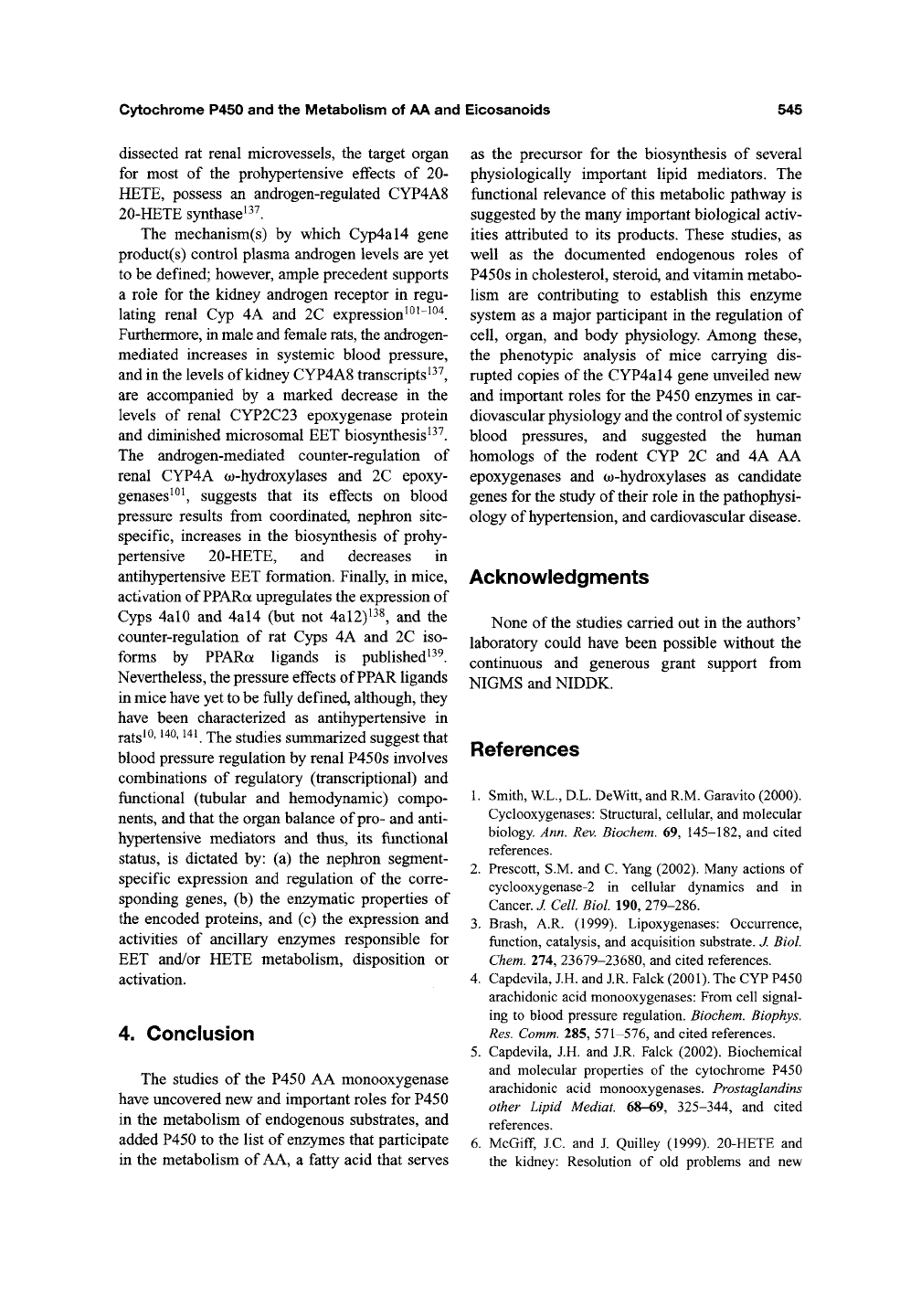
Cytochrome P450 and the Metabolism of AA and Eicosanoids
545
dissected rat renal microvessels, the target organ
for most of the prohypertensive effects of 20-
HETE, possess an androgen-regulated CYP4A8
20-HETE synthase^^^.
The mechanism(s) by which Cyp4al4 gene
product(s) control plasma androgen levels are yet
to be defined; however, ample precedent supports
a role for the kidney androgen receptor in regu-
lating renal Cyp 4A and 2C expression^^^"^^"^.
Furthermore, in male and female rats, the androgen-
mediated increases in systemic blood pressure,
and in the levels of kidney CYP4A8 transcripts ^^^,
are accompanied by a marked decrease in the
levels of renal CYP2C23 epoxygenase protein
and diminished microsomal EET biosynthesis^^^.
The androgen-mediated counter-regulation of
renal CYP4A w-hydroxylases and 2C epoxy-
genases^^^ suggests that its effects on blood
pressure results from coordinated, nephron site-
specific, increases in the biosynthesis of prohy-
pertensive 20-HETE, and decreases in
antihypertensive EET formation. Finally, in mice,
activ^ation of PPARa upregulates the expression of
Cyps 4al0 and 4al4 (but not 4al2)i3^ and the
counter-regulation of rat Cyps 4A and 2C iso-
forms by PPARa ligands is published^ ^^.
Nevertheless, the pressure effects of PPAR ligands
in mice have yet to be fully defined, although, they
have been characterized as antihypertensive in
rats^^'
140,141
jjjg studies summarized suggest that
blood pressure regulation by renal P450s involves
combinations of regulatory (transcriptional) and
functional (tubular and hemodynamic) compo-
nents,
and that the organ balance of
pro-
and anti-
hypertensive mediators and thus, its functional
status,
is dictated by: (a) the nephron segment-
specific expression and regulation of the corre-
sponding genes, (b) the enzymatic properties of
the encoded proteins, and (c) the expression and
activities of ancillary enzymes responsible for
EET and/or HETE metabolism, disposition or
activation.
4. Conclusion
The studies of the P450 AA monooxygenase
have uncovered new and important roles for P450
in the metabolism of endogenous substrates, and
added P450 to the list of enzymes that participate
in the metabolism of
AA,
a fatty acid that serves
as the precursor for the biosynthesis of several
physiologically important lipid mediators. The
functional relevance of this metabolic pathway is
suggested by the many important biological activ-
ities attributed to its products. These studies, as
well as the documented endogenous roles of
P450s in cholesterol, steroid, and vitamin metabo-
lism are contributing to establish this enzyme
system as a major participant in the regulation of
cell, organ, and body physiology. Among these,
the phenotypic analysis of mice carrying dis-
rupted copies of the CYP4al4 gene unveiled new
and important roles for the P450 enzymes in car-
diovascular physiology and the control of systemic
blood pressures, and suggested the human
homologs of the rodent CYP 2C and 4A AA
epoxygenases and ca-hydroxylases as candidate
genes for the study of their role in the pathophysi-
ology of hypertension, and cardiovascular disease.
Acknowledgments
None of the studies carried out in the authors'
laboratory could have been possible without the
continuous and generous grant support from
NIGMS and NIDDK.
References
1.
Smith, W.L., D.L. DeWitt, and R.M. Garavito (2000).
Cyclooxygenases: Structural, cellular, and molecular
biology. Ann. Rev. Biochem. 69, 145-182, and cited
references.
2.
Prescott, S.M. and C. Yang (2002). Many actions of
cyclooxygenase-2 in cellular dynamics and in
Cancer. J. Cell. Biol. 190, 279-286.
3.
Brash, A.R. (1999). Lipoxygenases: Occurrence,
function, catalysis, and acquisition substrate. J. Biol.
Chem.
214, 23679-23680, and cited references.
4.
Capdevila, J.H. and J.R. Falck (2001). The CYP P450
arachidonic acid monooxygenases: From cell signal-
ing to blood pressure regulation. Biochem. Biophys.
Res.
Comm. 285, 571-576, and cited references.
5.
Capdevila, J.H. and J.R. Falck (2002). Biochemical
and molecular properties of the cytochrome P450
arachidonic acid monooxygenases. Prostaglandins
other Lipid Mediat. 68-69, 325-344, and cited
references.
6.
McGiff,
J.C. and J. Quilley (1999). 20-HETE and
the kidney: Resolution of old problems and new

546 Jorge H. Capdevila et al.
beginnings. Am. J. Physiol. 277, R607-R623, and
cited references.
7.
McGiff,
J.C. and J. Quilley (2001). 20-Hydroxy-
eicosatetraenoic acid and epoxyeicosatrienoic acids
and blood pressure.
Curr.
Opin. Nephrol. Hypertens.
10,
31-237, and cited references.
8. Imig, J.D. (2000). Eicosanoid regulation of renal
vasculature. Am. J. Physiol. 279, F965-F981, and
cited references.
9. Campbell, W.B. and D.R. Harder (1999).
Endothelium-derived hyperpolarizing factors and
vascular cytochrome P450 metabolites of arachi-
donic acid in the regulation of tone. Circ. Res. 84,
484^88,
and cited references.
10.
Roman, R.J. (2002). P450 metabolites of arachi-
donic acid in the control of cardiovascular function.
Physiol. Rev. 82, 131-185, and cited references.
11.
Capdevila, J.H., N. Chacos, J. Werringloer,
R.A. Prough, and R.W. Estabrook (1981). Liver
microsomal cytochrome P-450 and the oxidative
metabolism of
AA.
Proc. Natl.
Acad.
Sci. USA 78,
5362-5366.
12.
Morrison, A.R. and
N.
Pascoe (1981). Metabolism of
AA through NADPH-dependent oxygenase of renal
cortex. Proc. Natl.
Acad.
Sci. USA 78, 7375-7378.
13.
Oliw, E.H. and J.A. Gates (1981). Oxygenation of
AA by hepatic microsomes of the rabbit.
Mechanism of biosynthesis of two vicinal diols.
Biochim. Biophys. Acta 666, 327-340.
14.
Jacobson, H.R., S. Corona, J.H. Capdevila,
N.
Chacos, S. Manna, A. Womack et al. (1984).
Effects of epoxyeicosatrienoic acids on ion trans-
port in the rabbit cortical collecting tubule. In
P.
Braquet, J.C. Frolich, S. Nicosia, and R. Garay
(eds),
Prostaglandins and Membrane Ion Transport.
Raven Press, New York, p. 311.
15.
Karara, A., E. Dishman, 1. Blair, J.R. Falck, and
J.H. Capdevila (1989). Endogenous epoxye-
icosatrienoic acids. Cytochrome P-450 controlled
stereoselectivity of the hepatic arachidonic acid
epoxygenase. ^ ^/o/. Chem. 264, 19822-19827.
16.
Kupfer, D. (1982). Endogenous substrates of
monooxygenases: Fatty acids and prostaglandins. In
J.B.
Schenkman and D. Kupfer (eds), Hepatic
Cytochrome P-450 Monooxygenase System.
Pergamon Press, New York, pp. 157-187.
17.
Sharma, R.K., M.V Doig, D.FV Lewis, and
G. Gibson (1989). Role of hepatic and renal
cytochrome P450 IVAl in the metabolism of lipid
substrates. Biochem. Pharmacol. 38, 3621-3629.
18.
Imaoka, S., S. Tanaka, and Y. Funae (1989).
(w/w-l) hydroxylation of lauric acid and arachi-
donic acid by rat renal cytochrome P-450. Biochem.
Int. 18,731-740.
19.
Johnson, E.E, D.L. Walker, and K.J. Griffin
(1990).
Cloning and expression of three rabbit
kidney cDNAs encoding lauric acid-hydroxylases.
Biochemistry 29, 873-879.
20.
Kikuta, Y., E. Kusunose, and M. Kusunose (2002).
Prostaglandin and leukotriene w-hydroxylases.
Prostaglandins other Lipid Mediat. 68-69,
325-344, and cited references.
21.
Rahimtula, A.D. and PJ. O'Brien (1974).
Hydroperoxide catalyzed liver microsomal aromatic
hydroxylation reactions involving cytochrome P-450.
Biochem. Biophys. Res. Commun. 60, 440-447.
22.
Weiss, R.H, XL. Arnold, and R.W. Estabrook
(1987).
Transformation of an arachidonic acid
hydroperoxide into epoxyhydroxy and trihydroxy
fatty acids by liver microsomal cytochrome P-450.
Arch.
Biochem. Biophys. 252, 334-338.
23.
Hecker, M. and V Ullrich (1989). On the mecha-
nism of prostacyclin and thromboxane A2 biosyn-
thesis.
^ Biol. Chem. 264, 141-150.
24.
Hara, S,, A. Miyata, C. Yokoyama, R. Brugger,
F Lottspeich, V Ullrich et al. (1995). Molecular
cloning and expression of prostacyclin synthase
from endothelial cells. Adv. Prostaglandin
Thromboxane Leukot. Res. 23, 121-123.
25.
Yokoyama, C, A. Miyata, H. Ihara, V Ullrich, and
T. Tanabe (1991). Molecular cloning of the human
platelet thromboxane A synthase. Biochem.
Biophys. Res. Commun. 178, 1479-1484.
26.
Ohashi, K., K.H. Ruan, R.J. Kulmacz, K.K. Wu, and
L.H. Wang (1992). Primary structure of human
thromboxane synthase determined from the cDNA
sequence.
J.
Biol. Chem. 261, 789-793
27.
White, R.E. and M.G. Coon (1980). Oxygen activa-
tion by cytochrome P-450. Ann. Rev. Biochem. 49,
315-356, and references therein.
28.
Wong, PY.K., K.U. Malik, B.M. Taylor,
WP Schneider, J.C.
McGiff,
and FE Sun (1985).
Epoxidation of prostacyclin in the rabbit kidney.
J. Biol. Chem. 260, 9150-9153.
29.
Oliw, E.H. (1984). Metabohsm of 5(6)-epoxy-
eicosatrienoic acid by ram seminal vesicles forma-
tion of novel prostaglandin Ej metabolites. Biochim.
Biophys. Acta. 793, 408^15.
30.
Zhang, J.Y, C. Prakash,
K.
Yamashita, and LA. Blair
(1992).
Regiospecific and enantioselective meta-
bolism of 8,9-epoxyeicosatrienoic acids by cyclooxy-
genase. Biochem. Biophys. Res. Commun. 183,
138-143.
31.
Jajoo, H.K., J.H. Capdevila, J.R. Falck, R.K. Bhatt,
and LA. Blair
(1992).
Metabolism of 12(R)-hydroxy-
eicosatetraenoic acid by rat liver microsomes.
Biochim. Biophys. Acta 1123, 110-116.
32.
Capdevila, J.,
P.
Mosset,
P.
Yadagiri, Sun Lumin, and
J.R. Falck (1988). NADPH-Dependent microsomal
metabolism of 14,15-epoxyeicosatrienoic acid to
diepoxides and epoxyalcohols. Arch. Biochem.
Biophys. 261, 122-132.

Cytochrome P450 and the Metabolism of AA and Eicosanoids
547
33.
Cowart, L.A., S. Wei, M.-S. Hsu, E.F. Johnson,
M.U Krishna, J.R. Falck et al. (2002). The CYP 4A
isoforms hydroxylate epoxyeicosatrienoic acids to
form high affinity peroxisome proliferator-activated
receptor
Hgands.
J.
Biol.
Chem. Ill, 35105-35112.
34.
Hamberg, M. and B. Samuelsson (1966).
Prostaglandins in human seminal plasma.
Prostaglandins and related factors. J. Biol Chem.
241,
257-263.
35.
Israelson, U, M. Hamberg, and B. Samuelsson
(1969).
Biosynthesis of 19-hydroxy-prostaglandin
A,.
Eur.
J. Biochem. 11, 390-394.
36.
Kupfer, D., I. Jansson, L.V Favreau,
A.D.
Theoharides, and J.B. Schenkman (1988).
Regioselective hydroxylation of prostaglandins by
constitutive forms of cytochrome P-450 from rat liver:
Formation of a novel metabolite by a female-speci-
fic P-450.
Arch.
Biochem. Biophys. 262, 186-195.
37.
Matsubara, S., S. Yamamoto, K. Sogawa,
N.
Yokotani, Y. Fujii-Kuriyama, M. Haniu et al.
(1987).
cDNA cloning and inducible expression
during pregnancy of the MRNA for rabbit pul-
monary prostaglandin oa-hydroxylase (cytochrome
P-450p-2). J. Biol. Chem. 62, 13366-13371.
38.
Sharma, R.K., M.V Doig, D.F.V Lewis, and
G. Gibson (1989). Role of hepatic and renal
cytochrome P450 IVAl in the metabolism of lipid
substrates. Biochem. Pharmacol. 38, 3621-3629.
39.
Yokotani, N., R. Bernhardt, K. Sogawa,
E. Kusunose, O. Gotoh, M. Kusunose et al. (1989).
Two forms of w-hydroxylase toward prostaglandin
A and laurate. cDNA cloning and their expression.
J. Biol. Chem. 264, 21665-21669.
40.
Kusonuse, E., A. Sawamura, H. Kawashima,
I. Kubota, and M. Kusunose (1989). Isolation of a
new form of cytochrome P450 with prostaglandin A
and fatty acid w-hydroxylase activities from rabbit
kidney cortex microsomes. J. Biochem. 106,
194-206.
41.
Kikuta, Y, E. Kusunose,
T.
Okumoto, I. Kubota, and
M. Kusunose (1990). Purification and partial char-
acterization of two forms of cytochrome P450 with
co-hydroxylase activity towards prostaglandin A and
fatty acids from rat liver microsomes. J. Biochem.
107,280-286
42.
Roman, L.J., C.A.N. Palmer, J.E. Clark,
A.S.
Muerhoff,
K.J. Griffin, E.F. Johnson et al.
(1993).
Expression of rabbit cytochrome P4504A
which catalyzes the w-hydroxylation of fatty acids,
and prostaglandins. Arch. Biochem. Biophys. 307,
57-67.
43.
Bylund, J., M. Hidestrand, M. Ingelman-Sundberg,
and E.H. Oliw (2000). Identification of CYP4F8
in human seminal vesicles as a prominent 19-
hydroxylase of prostaglandin endoperoxides.
J. Biol. Chem. 275, 21844-21849.
44.
Lasker, J.M., B.W. Chen, I.
Wolf,
B.P Blswck,
RD.
Wilson, and RK. Powell (2000). Formation of
20-hydroxyeicosatetraenoic acid, a vasoactive and
natriuretic eicosanoid in human kidney. J. Biol.
Chem.
264, 17845-17853.
45.
An updated list of P450 genes and sequences is found
at: http://dmelson.utmem.edu/CytochromeP450.html
46.
Imaoka, S., H. Ogawa, S. Kimura, and F.J. Gonzalez
(1993).
Complete cDNA sequence and cDNA-
directed expression of CYP4A11, a fatty acid
omega-hydroxylase expressed in human kidney.
DNA Cell Biol. 12, 893-899.
47.
Kawashima, H.,
T.
Naganuma, E. Kusunose,
T.
Kono,
R.
Yasumoto, K. Sugimura et
al.
(2000). Human fatty
acid (o-hydroxylase, CYP 4A11: Determination of
complete genomic sequence and characterization of
purified recombinant protein. Arch. Biochem.
Biophys. 378, 333-339.
48.
Bellamine,
A.,
Y.
Wang, M.R. Waterman, J.V Gainer,
E. Dawson, N.J. Brown et al. (2003). Characteri-
zation of the CYP4A11 gene, a second CYP4A gene
in humans. Arch. Biochem. Biophys. 409, 221-227.
49.
Wang, M.H., D.E. Stec, M. Balazy, V Mastyugin,
C.S. Yang, R.J. Roman et al. (1997). Cloning,
sequencing, and cDNA-directed expression of rat
renal CYP4A2: AA w-hydroxylation and 11,12-
epoxidation by CYP4A2 protein. Arch. Biochem.
Biophys. 336, 240-250.
50.
Helvig, C, E. Dishman, and J.H. Capdevila (1998).
Molecular, enzymatic, and regulatory characteriza-
tion of rat kidney cytochromes P450 4A2 and 4A3.
Biochemistry'M,
12546-12558.
51.
Hoch, U, Z. Zhang, D.L. Kroetz, and PR. Ortiz de
Montellano (2000). Structural determination of the
substrate specificities and regioselectivities of the
rat and human fatty acid omega hydroxylases. Arch.
Biochem. Biophys. 373,
63—71.
52.
Nishimoto, M., J.E. Clark, and B.S.S. Masters
(1993).
Cytochrome P450 4A4: Expression in
Escherichia coli, purification, and characteri-
zation of catalytic properties. Biochemistry 32,
8863-8870.
53.
Bylund, J., M. Bylund, and E.H. Oliw (2001).
cDNA cloning and expression of
CYP4F12,
a novel
human cytochrome P450. Biochem. Biophys. Res.
Commun. 280, 892-897.
54.
Yokomizo, T., T. Izumi, and T. Shimizu (2001).
Leukotriene B4: Metabolism and signal transduc-
tion. Arch. Biochem. Biophys. 385,
231-241,
and
cited references.
55.
Haeggstrom, J.Z. and A. Wetterholm (2002).
Enzymes and receptors in the leukotriene cascade.
Cell.
Mol. Life
Sci.
59, 742-753, and cited references.
56.
Powell, WS. (1984). Properties of leukotriene B4
20-hydroxylase from polymorphonuclear leuko-
cytes.
J. Biol. Chem. 259, 3082-3089.
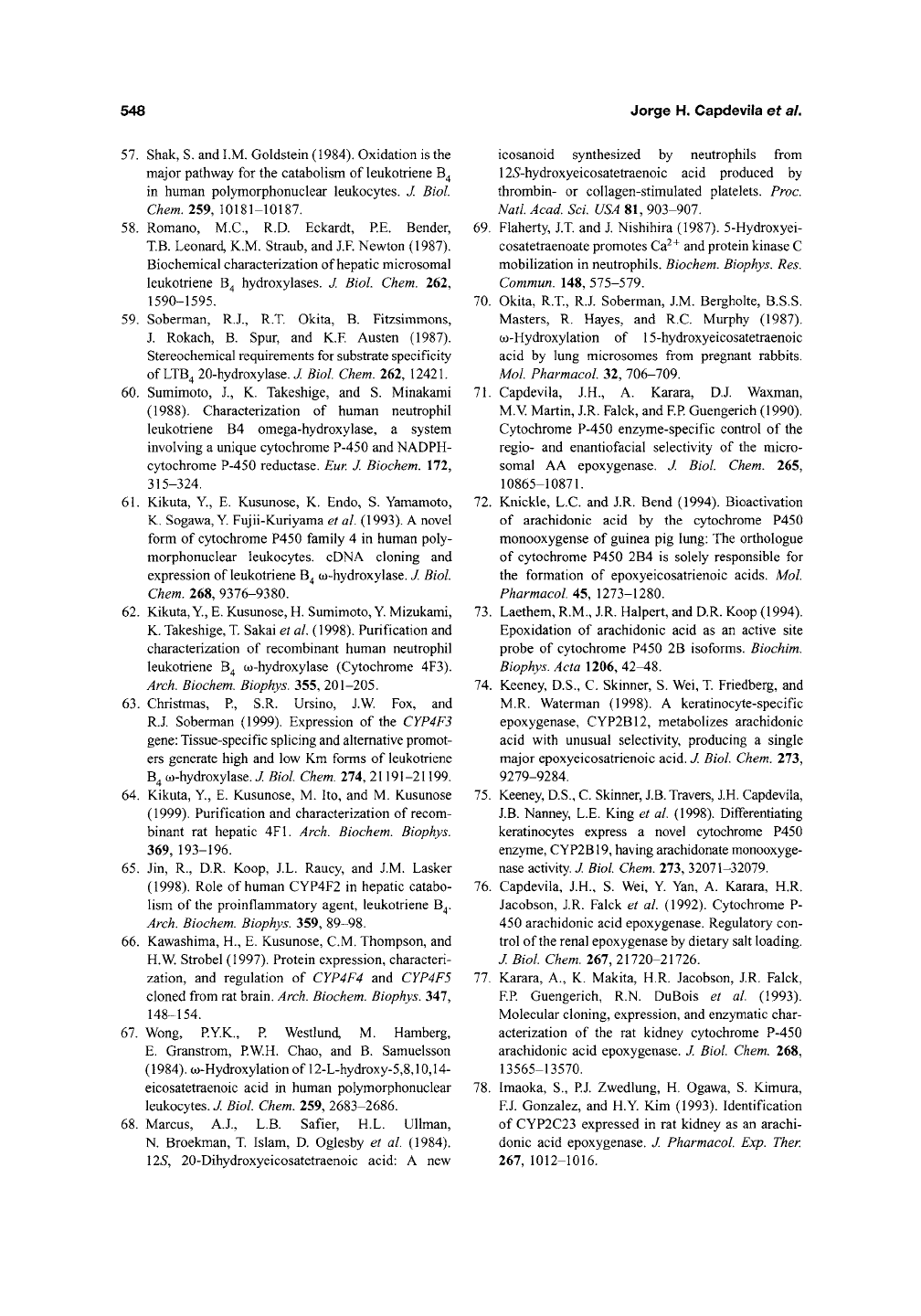
548
Jorge H. Capdevila et al.
57.
Shak, S. and I.M. Goldstein (1984). Oxidation is the
major pathway for the catabolism of leukotriene B4
in human polymorphonuclear leukocytes. J. Biol.
Chem.
259, 10181-10187.
58.
Romano, M.C., R.D. Eckardt, RE. Bender,
T.B.
Leonard, K.M. Straub, and J.K Newton (1987).
Biochemical characterization of hepatic microsomal
leukotriene B^ hydroxylases. J. Biol Chem. 262,
1590-1595.
59.
Soberman, R.J., R.T. Okita, B. Fitzsimmons,
J. Rokach, B. Spur, and K.F. Austen (1987).
Stereochemical requirements for substrate specificity
of
LTB4
20-hydroxylase. J. Biol. Chem. 262,
12421.
60.
Sumimoto, J., K. Takeshige, and S. Minakami
(1988).
Characterization of human neutrophil
leukotriene B4 omega-hydroxylase, a system
involving a unique cytochrome P-450 and NADPH-
cytochrome P-450 reductase. Eur. J. Biochem. 172,
315-324.
61.
Kikuta, Y., E. Kusunose, K. Endo, S. Yamamoto,
K. Sogawa,
Y.
Fujii-Kuriyama et al. (1993). A novel
form of cytochrome P450 family 4 in human poly-
morphonuclear leukocytes. cDNA cloning and
expression of leukotriene B^ co-hydroxylase.
J.
Biol.
Chem.
268, 9376-9380.
62.
Kikuta, Y, E. Kusunose, H. Sumimoto, Y Mizukami,
K. Takeshige,
T.
Sakai et al. (1998). Purification and
characterization of recombinant human neutrophil
leukotriene B^ w-hydroxylase (Cytochrome 4F3).
Arch.
Biochem. Biophys. 355, 201-205.
63.
Christmas, P, S.R. Ursino, J.W. Fox, and
R.J. Soberman (1999). Expression of the CYP4F3
gene:
Tissue-specific splicing and alternative promot-
ers generate high and low Km forms of leukotriene
B4 w-hydroxylase. J. Biol. Chem. 214, 21191-21199.
64.
Kikuta, Y, E. Kusunose, M. Ito, and M. Kusunose
(1999).
Purification and characterization of recom-
binant rat hepatic 4F1. Arch. Biochem. Biophys.
369,
193-196.
65.
Jin, R., D.R. Koop, J.L. Raucy, and J.M. Lasker
(1998).
Role of human CYP4F2 in hepatic catabo-
lism of the proinflammatory agent, leukotriene B^.
Arch.
Biochem. Biophys. 359, 89-98.
66.
Kawashima, H., E. Kusunose, CM. Thompson, and
H.W. Strobel (1997). Protein expression, characteri-
zation, and regulation of CYP4F4 and CYP4F5
cloned from rat brain. Arch. Biochem. Biophys. 347,
148-154.
67.
Wong, PYK., P Westlund, M. Hamberg,
E. Granstrom, P.W.H. Chao, and B. Samuelsson
(1984).
(o-Hydroxylation of 12-L-hydroxy-5,8,10,14-
eicosatetraenoic acid in human polymorphonuclear
leukocytes. J. Biol Chem. 259, 2683-2686.
68.
Marcus, A.J., L.B. Safier, H.L. Ullman,
N.
Broekman, T. Islam, D. Oglesby et al. (1984).
lis,
20-Dihydroxyeicosatetraenoic acid: A new
icosanoid synthesized by neutrophils from
125-hydroxyeicosatetraenoic acid produced by
thrombin- or collagen-stimulated platelets. Proc.
Natl.
Acad.
Sci. USA 81, 903-907.
69.
Flaherty, J.T and J. Nishihira (1987). 5-Hydroxyei-
cosatetraenoate promotes Ca^^ and protein kinase C
mobilization in neutrophils. Biochem. Biophys. Res.
Commun. 148, 575-579.
70.
Okita, R.T., R.J. Soberman, J.M. Bergholte, B.S.S.
Masters, R. Hayes, and R.C. Murphy (1987).
(o-Hydroxylation of 15-hydroxyeicosatetraenoic
acid by lung microsomes from pregnant rabbits.
Mol. Pharmacol. 32, 706-709.
71.
Capdevila, J.H., A. Karara, D.J. Waxman,
M.V Martin, J.R. Falck, and FP Guengerich (1990).
Cytochrome P-450 enzyme-specific control of the
regio-
and enantiofacial selectivity of the micro-
somal AA epoxygenase. J. Biol. Chem. 265,
10865-10871.
72.
Knickle, L.C. and J.R. Bend (1994). Bioactivation
of arachidonic acid by the cytochrome P450
monooxygense of guinea pig lung: The orthologue
of cytochrome P450 2B4 is solely responsible for
the formation of epoxyeicosatrienoic acids. Mol.
Pharmacol. 45, 1273-1280.
73.
Laethem, R.M., J.R. Halpert, and D.R. Koop (1994).
Epoxidation of arachidonic acid as an active site
probe of cytochrome P450 2B isoforms. Biochim.
Biophys. Acta 1206, 42^8.
74.
Keeney, D.S., C. Skinner, S. Wei, T. Friedberg, and
M.R. Waterman (1998). A keratinocyte-specific
epoxygenase, CYP2B12, metabolizes arachidonic
acid with unusual selectivity, producing a single
major epoxyeicosatrienoic acid.
J.
Biol. Chem. 273,
9279-9284.
75.
Keeney, D.S., C. Skinner,
J.B.
Travers, J.H. Capdevila,
J.B.
Nanney L.E. King et al. (1998). Differentiating
keratinocytes express a novel cytochrome P450
enzyme, CYP2B19, having arachidonate monooxyge-
nase activity.
J.
Biol. Chem.
112,,
32071-32079.
76.
Capdevila, J.H., S. Wei, Y Yan, A. Karara, H.R.
Jacobson, J.R. Falck et al. (1992). Cytochrome P-
450 arachidonic acid epoxygenase. Regulatory con-
trol of the renal epoxygenase by dietary salt loading.
J. Biol. Chem. 267, 21720-21726.
77.
Karara, A., K. Makita, H.R. Jacobson, J.R. Falck,
FP Guengerich, R.N. DuBois et al. (1993).
Molecular cloning, expression, and enzymatic char-
acterization of the rat kidney cytochrome P-450
arachidonic acid epoxygenase. J. Biol. Chem. 268,
13565-13570.
78.
Imaoka, S., P.J. Zwedlung, H. Ogawa, S. Kimura,
FJ. Gonzalez, and H.Y Kim (1993). Identification
of CYP2C23 expressed in rat kidney as an arachi-
donic acid epoxygenase. J. Pharmacol. Exp. Then
267,
1012-1016.
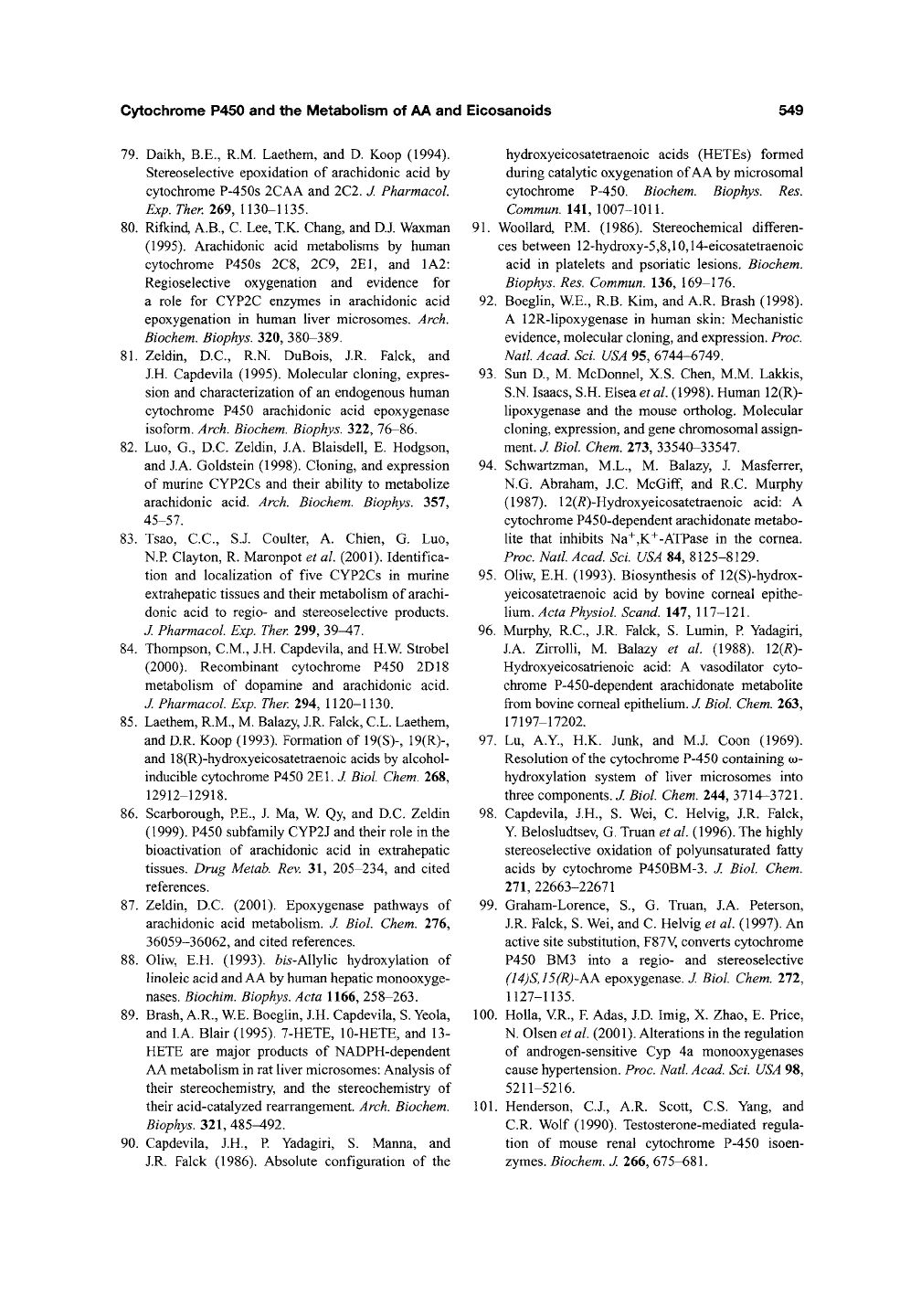
Cytochrome P450 and the Metabolism of AA and Eicosanoids
549
79.
Daikh, B.E., R.M. Laethem, and D. Koop (1994).
Stereoselective epoxidation of arachidonic acid by
cytochrome P-450s 2CAA and 2C2. J. Pharmacol.
Exp.
Then 269, 1130-1135.
80.
Rifkind, A.B., C. Lee, T.K. Chang, and D.J. Waxman
(1995).
Arachidonic acid metabolisms by human
cytochrome P450s 2C8, 2C9, 2E1, and 1A2:
Regioselective oxygenation and evidence for
a role for CYP2C enzymes in arachidonic acid
epoxygenation in human liver microsomes. Arch.
Biochem. Biophys. 320, 380-389.
81.
Zeldin, D.C., R.N. DuBois, J.R. Falck, and
J.H. Capdevila (1995). Molecular cloning, expres-
sion and characterization of an endogenous human
cytochrome P450 arachidonic acid epoxygenase
isoform. Arch. Biochem. Biophys. 322, 76-86.
82.
Luo, G., D.C. Zeldin, J.A. Blaisdell, E. Hodgson,
and J.A. Goldstein (1998). Cloning, and expression
of murine CYP2Cs and their ability to metabolize
arachidonic acid. Arch. Biochem. Biophys. 357,
45-57.
83.
Tsao, C.C, S.J. Coulter, A. Chien, G. Luo,
N.R Clayton, R. Maronpot et al (2001). Identifica-
tion and localization of five CYP2Cs in murine
extrahepatic tissues and their metabolism of arachi-
donic acid to regio- and stereoselective products.
J. Pharmacol. Exp. Ther 299, 39^7.
84.
Thompson, CM., J.H. Capdevila, and H.W. Strobel
(2000).
Recombinant cytochrome P450 2D 18
metabolism of dopamine and arachidonic acid.
J. Pharmacol. Exp. Ther 294, 1120-1130.
85.
Laethem, R.M., M. Balazy, J.R. Falck, C.L. Laethem,
and D.R. Koop (1993). Formation of 19(S)-, 19(R)-,
and 18(R)-hydroxyeicosatetraenoic acids by alcohol-
inducible cytochrome P450
2E1.
J Biol. Chem. 268,
12912-12918.
86.
Scarborough, RE., J. Ma, W. Qy, and D.C. Zeldin
(1999).
P450 subfamily CYP2J and their role in the
bioactivation of arachidonic acid in extrahepatic
tissues. Drug Metab. Rev. 31, 205-234, and cited
references.
87.
Zeldin, D.C. (2001). Epoxygenase pathways of
arachidonic acid metabolism. J. Biol. Chem. 216,
36059-36062, and cited references.
88.
Oliw, E.H. (1993). bis-AWylic hydroxylation of
linoleic acid and AA by human hepatic monooxyge-
nases.
Biochim. Biophys. Acta 1166, 258-263.
89.
Brash, A.R., W.E. Boeglin, J.H. Capdevila,
S.
Yeola,
and LA. Blair (1995). 7-HETE, 10-HETE, and 13-
HETE are major products of NADPH-dependent
A A metabolism in rat liver microsomes: Analysis of
their stereochemistry, and the stereochemistry of
their acid-catalyzed rearrangement. Arch. Biochem.
Biophys. 321, 485^92.
90.
Capdevila, J.H., P. Yadagiri, S. Manna, and
J.R. Falck (1986). Absolute configuration of the
hydroxyeicosatetraenoic acids (HETEs) formed
during catalytic oxygenation of AA by microsomal
cytochrome P-450. Biochem. Biophys. Res.
Commun. 141, 1007-1011.
91.
WooUard, PM. (1986). Stereochemical differen-
ces between 12-hydroxy-5,8,10,14-eicosatetraenoic
acid in platelets and psoriatic lesions. Biochem.
Biophys. Res. Commun. 136, 169-176.
92.
Boeglin, W.E., R.B. Kim, and A.R. Brash (1998).
A 12R-lipoxygenase in human skin: Mechanistic
evidence, molecular cloning, and expression. Proc.
Natl.
Acad.
Sci. USA 95, 6744-6749.
93.
Sun D., M. McDonnel, X.S. Chen, M.M. Lakkis,
S.N. Isaacs, S.H. Elsea
etal.
(1998). Human 12(R)-
lipoxygenase and the mouse ortholog. Molecular
cloning, expression, and gene chromosomal assign-
ment. J. Biol. Chem. 273, 33540-33547.
94.
Schwartzman, M.L., M. Balazy, J. Masferrer,
N.G.
Abraham, J.C.
McGiff,
and R.C. Murphy
(1987).
12(i?)-Hydroxyeicosatetraenoic acid: A
cytochrome P450-dependent arachidonate metabo-
lite that inhibits Na^,K+-ATPase in the cornea.
Proc. Natl.
Acad.
Sci. USA 84, 8125-8129.
95.
Oliw, E.H. (1993). Biosynthesis of 12(S)-hydrox-
yeicosatetraenoic acid by bovine corneal epithe-
lium, ^c^a P/i^^w/.
Scand.
147,
117-121.
96.
Murphy, R.C, J.R. Falck, S. Lumin, P Yadagiri,
J.A. ZirroUi, M. Balazy et al (1988). \2{Ry
Hydroxyeicosatrienoic acid: A vasodilator cyto-
chrome P-450-dependent arachidonate metabolite
from bovine corneal epithelium.
J.
Biol. Chem. 263,
17197-17202.
97.
Lu, A.Y., H.K. Junk, and M.J. Coon (1969).
Resolution of the cytochrome P-450 containing w-
hydroxylation system of liver microsomes into
three components. J. Biol. Chem. 244, 3714-3721.
98.
Capdevila, J.H., S. Wei, C Helvig, J.R. Falck,
Y. Belosludtsev, G. Truan et al. (1996). The highly
stereoselective oxidation of polyunsaturated fatty
acids by cytochrome P450BM-3. J. Biol. Chem.
Ill, 22663-22671
99.
Graham-Lorence, S., G. Truan, J.A. Peterson,
J.R. Falck, S. Wei, and C Helvig et al. (1997). An
active site substitution, F87V, converts cytochrome
P450 BM3 into a regio- and stereoselective
(14)S,15(R)-AA epoxygenase. J. Biol. Chem. 272,
1127-1135.
100.
Holla, VR., E Adas, J.D. Imig, X. Zhao, E. Price,
N.
Olsen et al. (2001). Alterations in the regulation
of androgen-sensitive Cyp 4a monooxygenases
cause hypertension. Proc. Natl.
Acad.
Sci. USA 98,
5211-5216.
101.
Henderson, C.J., A.R. Scott, CS. Yang, and
CR. Wolf (1990). Testosterone-mediated regula-
tion of mouse renal cytochrome P-450 isoen-
zymes. Biochem. J. 266,
675-681.
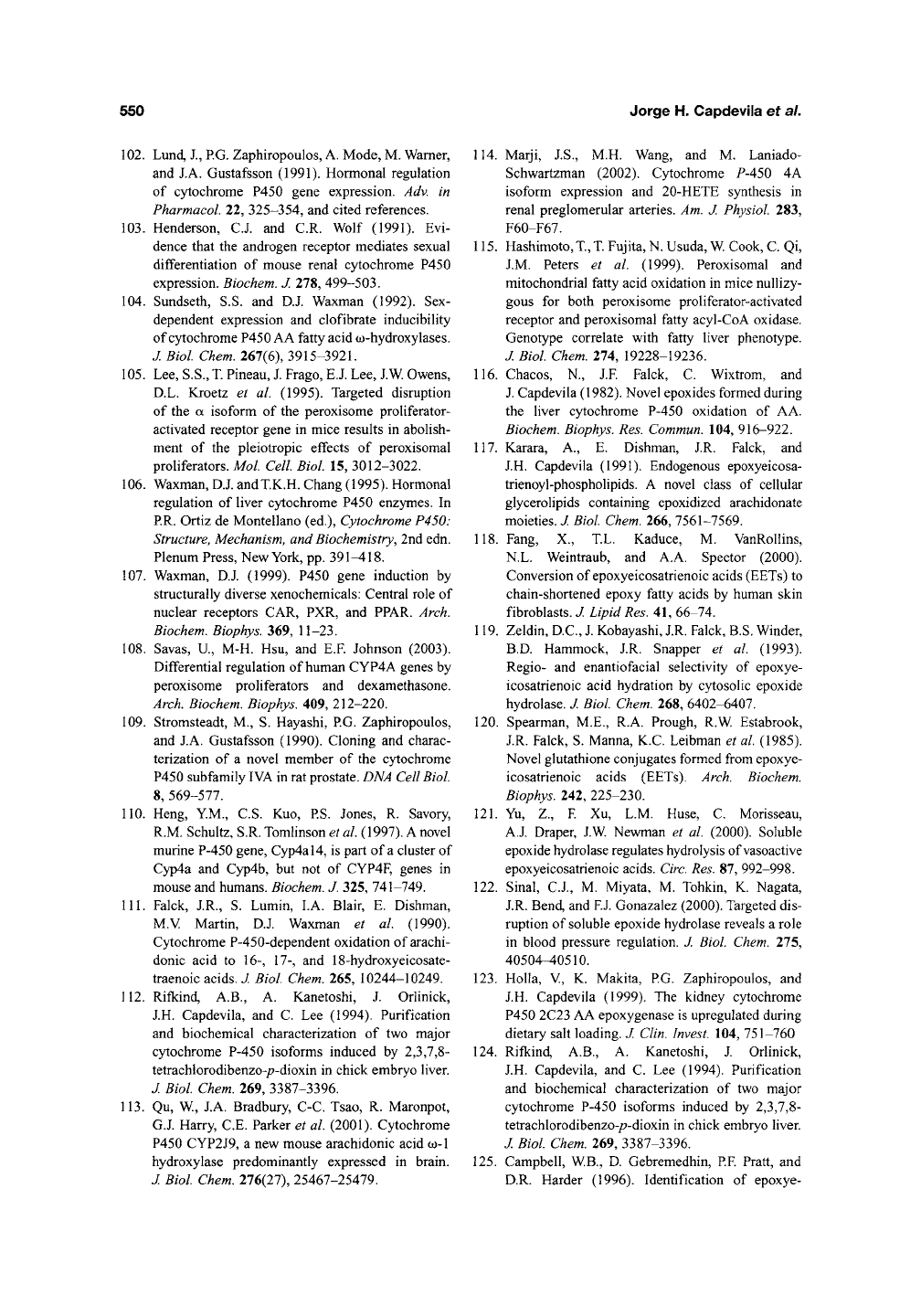
550 Jorge H. Capdevila et al.
102.
Lund, J., P.G. Zaphiropoulos, A. Mode, M. Warner,
and J.A. Gustafsson (1991). Hormonal regulation
of cytochrome P450 gene expression. Adv. in
Pharmacol. 22, 325-354, and cited references.
103.
Henderson, C.J. and C.R. Wolf (1991). Evi-
dence that the androgen receptor mediates sexual
differentiation of mouse renal cytochrome P450
expression. Biochem. J. 278, 499-503.
104.
Sundseth, S.S. and D.J. Waxman (1992). Sex-
dependent expression and clofibrate inducibility
of cytochrome P450 AA fatty acid w-hydroxylases.
J. Biol. Chem. 267(6), 3915-3921.
105.
Lee, S.S.,
T.
Pineau, J. Frago, E.J. Lee, J.W. Owens,
D.L. Kroetz et al. (1995). Targeted disruption
of the a isoform of the peroxisome proliferator-
activated receptor gene in mice results in abolish-
ment of the pleiotropic effects of peroxisomal
proHferators. Mol. Cell. Biol. 15, 3012-3022.
106.
Waxman, D.J. andT.K.H. Chang (1995). Hormonal
regulation of liver cytochrome P450 enzymes. In
PR. Ortiz de Montellano (ed.). Cytochrome P450:
Structure, Mechanism, and Biochemistry, 2nd edn.
Plenum Press, New York, pp. 391^18.
107.
Waxman, D.J. (1999). P450 gene induction by
structurally diverse xenochemicals: Central role of
nuclear receptors CAR, PXR, and PPAR. Arch.
Biochem. Biophys. 369,
11-23.
108.
Savas, U, M-H. Hsu, and E.R Johnson (2003).
Differential regulation of human CYP4A genes by
peroxisome prohferators and dexamethasone.
Arch.
Biochem. Biophys. 409, 212-220.
109.
Stromsteadt, M., S. Hayashi, P.G. Zaphiropoulos,
and J.A. Gustafsson (1990). Cloning and charac-
terization of a novel member of the cytochrome
P450 subfamily IVA in rat prostate. DNA
Cell
Biol.
8, 569-577.
110.
Heng, Y.M., C.S. Kuo, PS. Jones, R. Savory,
R.M. Schultz, S.R. Tomlinson et
al.
(1997). A novel
murine P-450 gene, Cyp4al4, is part of
a
cluster of
Cyp4a and Cyp4b, but not of CYP4F, genes in
mouse and humans. Biochem. J. 325, 741-749.
111.
Falck, J.R., S. Lumin, I.A. Blair, E. Dishman,
M.V Martin, D.J. Waxman et al. (1990).
Cytochrome P-450-dependent oxidation of arachi-
donic acid to 16-, 17-, and 18-hydroxyeicosate-
traenoic acids. J. Biol. Chem. 265, 10244-10249.
112.
Rifkind, A.B., A. Kanetoshi, J. Orlinick,
J.H. Capdevila, and C. Lee (1994). Purification
and biochemical characterization of two major
cytochrome P-450 isoforms induced by 2,3,7,8-
tetrachlorodibenzo-/7-dioxin in chick embryo liver.
J. Biol. Chem. 269, 3387-3396.
113.
Qu, W, J.A. Bradbury, C-C. Tsao, R. Maronpot,
G.J. Harry, C.E. Parker et al. (2001). Cytochrome
P450 CYP2J9, a new mouse arachidonic acid co-1
hydroxylase predominantly expressed in brain.
J. Biol. Chem. 276(27), 25467-25479.
114.
Marji, IS., M.H. Wang, and M. Laniado-
Schwartzman (2002). Cytochrome P-450 4A
isoform expression and 20-HETE synthesis in
renal preglomerular arteries. Am. J. Physiol. 283,
F60-F67.
115.
Hashimoto,
T., T.
Fujita, N. Usuda, W Cook, C. Qi,
J.M. Peters et al. (1999). Peroxisomal and
mitochondrial fatty acid oxidation in mice nullizy-
gous for both peroxisome proliferator-activated
receptor and peroxisomal fatty acyl-CoA oxidase.
Genotype correlate with fatty liver phenotype.
J. Biol. Chem. 274, 19228-19236.
116.
Chacos, N., J.R Falck, C. Wixtrom, and
J. Capdevila (1982). Novel epoxides formed during
the liver cytochrome P-450 oxidation of A A.
Biochem. Biophys. Res. Commun. 104, 916-922.
117.
Karara, A., E. Dishman, J.R. Falck, and
J.H. Capdevila (1991). Endogenous epoxyeicosa-
trienoyl-phospholipids. A novel class of cellular
glycerolipids containing epoxidized arachidonate
moieties. ^ 5/o/. Chem. 266, 7561-7569.
118.
Fang, X., T.L. Kaduce, M. VanRollins,
N.L.
Weintraub, and A.A. Spector (2000).
Conversion of epoxyeicosatrienoic acids (EETs) to
chain-shortened epoxy fatty acids by human skin
fibroblasts.
J.
Lipid
Res.
41, 66-74.
119.
Zeldin, DC, J. Kobayashi, J.R. Falck, B.S. Winder,
B.D.
Hammock, J.R. Snapper et al. (1993).
Regio- and enantiofacial selectivity of epoxye-
icosatrienoic acid hydration by cytosolic epoxide
hydrolase. J. Biol. Chem. 268, 6402-6407.
120.
Spearman, M.E., R.A. Prough, R.W Estabrook,
J.R. Falck, S. Manna, K.C. Leibman et al. (1985).
Novel glutathione conjugates formed from epoxye-
icosatrienoic acids (EETs). Arch. Biochem.
Biophys. 242, 225-230.
121.
Yu, Z., F Xu, L.M. Huse, C. Morisseau,
A.J. Draper, J.W Newman et al. (2000). Soluble
epoxide hydrolase regulates hydrolysis of vasoactive
epoxyeicosatrienoic acids.
Circ.
Res. 87, 992-998.
122.
Sinai, C.J., M. Miyata, M. Tohkin, K. Nagata,
J.R. Bend, and F.J. Gonazalez (2000). Targeted dis-
ruption of soluble epoxide hydrolase reveals a role
in blood pressure regulation. J. Biol. Chem. 275,
40504-40510.
123.
Holla, V, K. Makita, P.G. Zaphiropoulos, and
J.H. Capdevila (1999). The kidney cytochrome
P450 2C23 AA epoxygenase is upregulated during
dietary salt loading. J. Clin. Invest. 104, 751-760
124.
Rifkind, A.B., A. Kanetoshi, J. Orlinick,
J.H. Capdevila, and C. Lee (1994). Purification
and biochemical characterization of two major
cytochrome P-450 isoforms induced by 2,3,7,8-
tetrachlorodibenzo-/7-dioxin in chick embryo liver.
J. Biol. Chem. 269, 3387-3396.
125.
Campbell, W.B., D. Gebremedhin, PF Pratt, and
D.R. Harder (1996). Identification of epoxye-
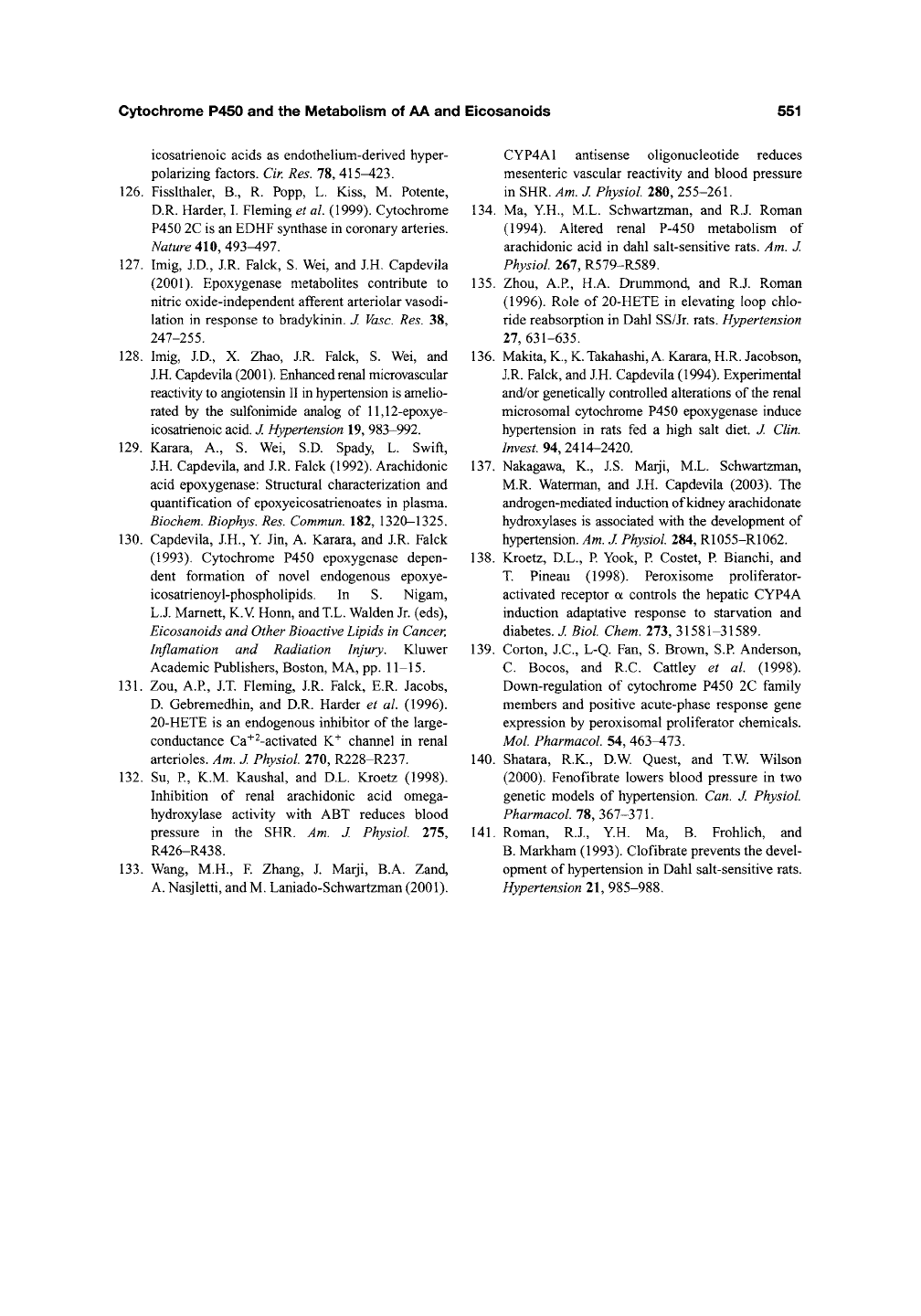
Cytochrome P450 and the Metabolism of AA and Eicosanoids 551
icosatrienoic acids as endothelium-derived hyper-
polarizing factors.
Cir.
Res. 78, 415^23.
126.
Fisslthaler, B., R. Popp, L. Kiss, M. Potente,
D.R. Harder, I. Fleming et al. (1999). Cytochrome
P450 2C is an EDHF synthase in coronary arteries.
Nature 410, 493-497.
127.
Imig, J.D., J.R. Falck, S. Wei, and J.H. Capdevila
(2001).
Epoxygenase metabolites contribute to
nitric oxide-independent afferent arteriolar vasodi-
lation in response to bradykinin. J.
Vase.
Res. 38,
247-255.
128.
Imig, J.D., X. Zhao, J.R. Falck, S. Wei, and
J.H. Capdevila
(2001).
Enhanced renal microvascular
reactivity to angiotensin II in hypertension is amelio-
rated by the sulfonimide analog of 11,12-epoxye-
icosatrienoic acid.
J.
Hypertension
19, 983-992.
129.
Karara, A., S. Wei, S.D. Spady, L. Swift,
J.H. Capdevila, and J.R. Falck (1992). Arachidonic
acid epoxygenase: Structural characterization and
quantification of epoxyeicosatrienoates in plasma.
Biochem. Biophys. Res. Commun. 182, 1320-1325.
130.
Capdevila, J.H., Y. Jin, A. Karara, and J.R. Falck
(1993).
Cytochrome P450 epoxygenase depen-
dent formation of novel endogenous epoxye-
icosatrienoyl-phospholipids. In S. Nigam,
L.J. Marnett, K.V Honn, andT.L. Walden Jr. (eds),
Eicosanoids and Other Bioactive Lipids in Cancer,
Inflamation and Radiation Injury. Kluwer
Academic Publishers, Boston, MA, pp. 11-15.
131.
Zou, A.P, J.T. Fleming, J.R. Falck, E.R. Jacobs,
D.
Gebremedhin, and D.R. Harder et al. (1996).
20-HETE is an endogenous inhibitor of the large-
conductance Ca^^-activated K+ channel in renal
arterioles. Am. J. Physiol. 270, R228-R237.
132.
Su, P, K.M. Kaushal, and D.L. Kroetz (1998).
Inhibition of renal arachidonic acid omega-
hydroxylase activity with ABT reduces blood
pressure in the SHR. Am. J. Physiol. 215,
R426-R438.
133.
Wang, M.H., E Zhang, J. Marji, B.A. Zand,
A. Nasjletti, and M. Laniado-Schwartzman (2001).
CYP4A1 antisense oligonucleotide reduces
mesenteric vascular reactivity and blood pressure
in SHR. Am. J. Physiol. 280,
255-261.
134.
Ma, Y.H., M.L. Schwartzman, and R.J. Roman
(1994).
Altered renal P-450 metabolism of
arachidonic acid in dahl salt-sensitive rats. Am. J.
Physiol. 267, R579-R589.
135.
Zhou, A.P, H.A. Drummond, and R.J. Roman
(1996).
Role of 20-HETE in elevating loop chlo-
ride reabsorption in Dahl SS/Jr. rats. Hypertension
27,631-635.
136.
Makita, K., K. Takahashi,
A.
Karara, H.R. Jacobson,
J.R. Falck, and J.H. Capdevila (1994). Experimental
and/or genetically controlled alterations of the renal
microsomal cytochrome P450 epoxygenase induce
hypertension in rats fed a high salt diet. J. Clin.
Invest. 94, 2414-2420.
137.
Nakagawa, K., J.S. Marji, M.L. Schwartzman,
M.R. Waterman, and J.H. Capdevila (2003). The
androgen-mediated induction of kidney arachidonate
hydroxylases is associated with the development of
hypertension. Am. J.
Physiol.
284, R1055-R1062.
138.
Kroetz, D.L., P Yook, P Costet, P Bianchi, and
T. Pineau (1998). Peroxisome proliferator-
activated receptor a controls the hepatic CYP4A
induction adaptative response to starvation and
diabetes. J. Biol. Chem. 273, 31581-31589.
139.
Corton, J.C, L-Q. Fan, S. Brown, S.P Anderson,
C. Bocos, and R.C. Cattley et al. (1998).
Down-regulation of cytochrome P450 2C family
members and positive acute-phase response gene
expression by peroxisomal proliferator chemicals.
Mol. Pharmacol. 54, 463^73.
140.
Shatara, R.K., D.W. Quest, and T.W Wilson
(2000).
Fenofibrate lowers blood pressure in two
genetic models of hypertension. Can. J. Physiol.
Pharmacol. IS, 361-311.
141.
Roman, R.J., Y.H. Ma, B. Frohlich, and
B.
Markham (1993). Clofibrate prevents the devel-
opment of hypertension in Dahl salt-sensitive rats.
Hypertension 21, 985-988.
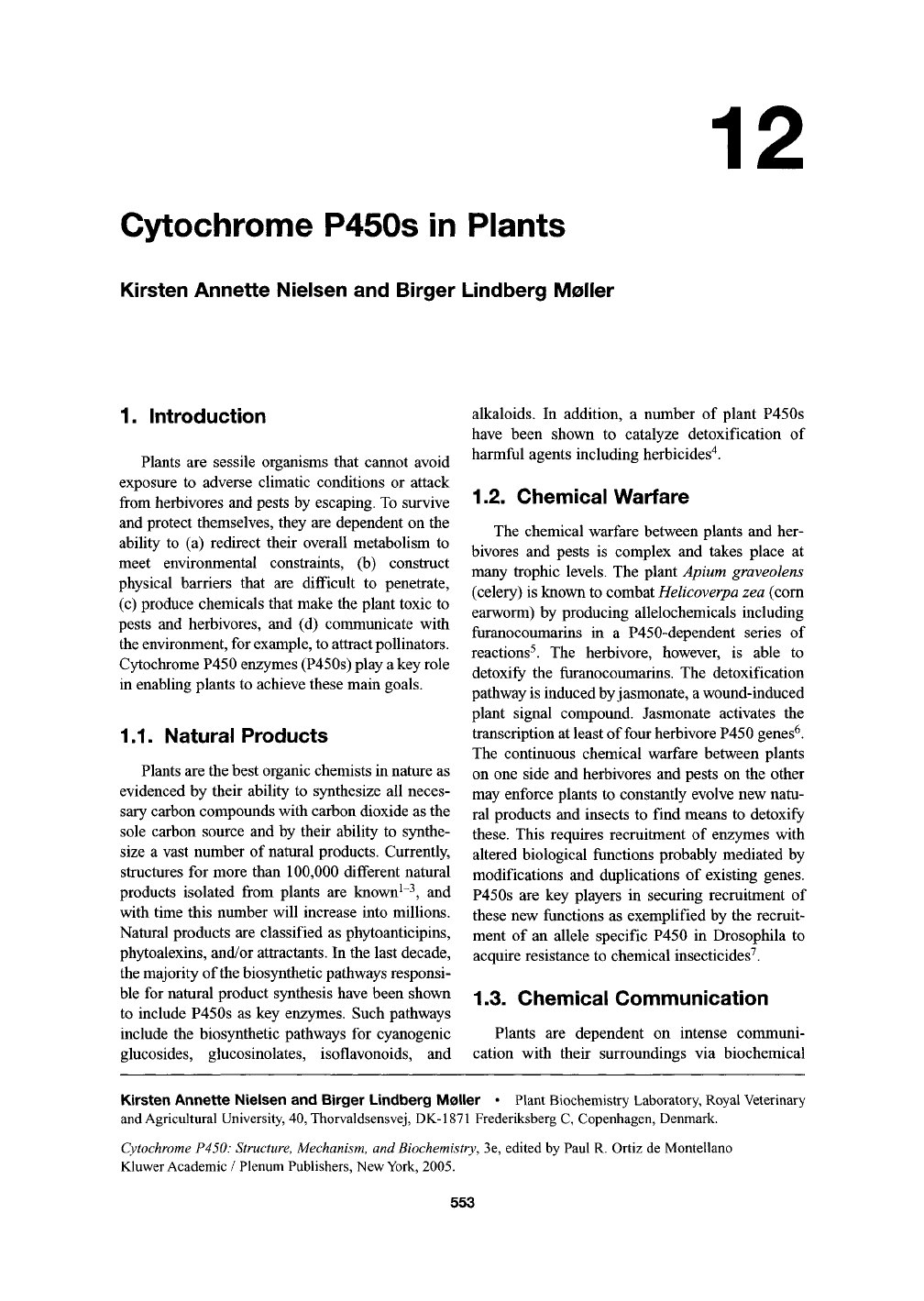
12
Cytochrome P450s in Plants
Kirsten Annette Nielsen and Birger Lindberg Meller
1.
Introduction
Plants are sessile organisms that cannot avoid
exposure to adverse climatic conditions or attack
from herbivores and pests by escaping. To survive
and protect themselves, they are dependent on the
ability to (a) redirect their overall metabolism to
meet environmental constraints, (b) construct
physical barriers that are difficult to penetrate,
(c) produce chemicals that make the plant toxic to
pests and herbivores, and (d) communicate with
the environment, for example, to attract pollinators.
Cytochrome P450 enzymes (P450s) play a key role
in enabling plants to achieve these main goals.
1.1.
Natural Products
Plants are the best organic chemists in nature as
evidenced by their ability to synthesize all neces-
sary carbon compounds with carbon dioxide as the
sole carbon source and by their ability to synthe-
size a vast number of natural products. Currently,
structures for more than 100,000 different natural
products isolated from plants are known^~^, and
with time this number will increase into millions.
Natural products are classified as phytoanticipins,
phytoalexins, and/or attractants. In the last decade,
the majority of the biosynthetic pathways responsi-
ble for natural product synthesis have been shown
to include P450s as key enzymes. Such pathways
include the biosynthetic pathways for cyanogenic
glucosides, glucosinolates, isoflavonoids, and
alkaloids. In addition, a number of plant P450s
have been shown to catalyze detoxification of
harmfiil agents including herbicides'^.
1.2. Chemical Warfare
The chemical warfare between plants and her-
bivores and pests is complex and takes place at
many trophic levels. The plant Apium graveolens
(celery) is known to combat Helicoverpa zea (com
earworm) by producing allelochemicals including
fiiranocoumarins in a P450-dependent series of
reactions^. The herbivore, however, is able to
detoxify the friranocoumarins. The detoxification
pathway is induced by jasmonate, a wound-induced
plant signal compound. Jasmonate activates the
transcription at least of four herbivore P450 genes^.
The continuous chemical warfare between plants
on one side and herbivores and pests on the other
may enforce plants to constantly evolve new natu-
ral products and insects to find means to detoxify
these. This requires recruitment of enzymes with
altered biological functions probably mediated by
modifications and duplications of existing genes.
P450s are key players in securing recruitment of
these new functions as exemplified by the recruit-
ment of an allele specific P450 in Drosophila to
acquire resistance to chemical insecticides^.
1.3. Chemical Communication
Plants are dependent on intense communi-
cation with their surroundings via biochemical
Kirsten Annette Nielsen and Birger Lindberg IVIoller • Plant Biochemistry Laboratory, Royal Veterinary
and Agricultural University, 40, Thorvaldsensvej, DK-1871 Frederiksberg C, Copenhagen, Denmark.
Cytochrome P450: Structure, Mechanism, and Biochemistry, 3e, edited by Paul R. Ortiz de Montellano
Kluwer Academic / Plenum Publishers, New
York,
2005.
553
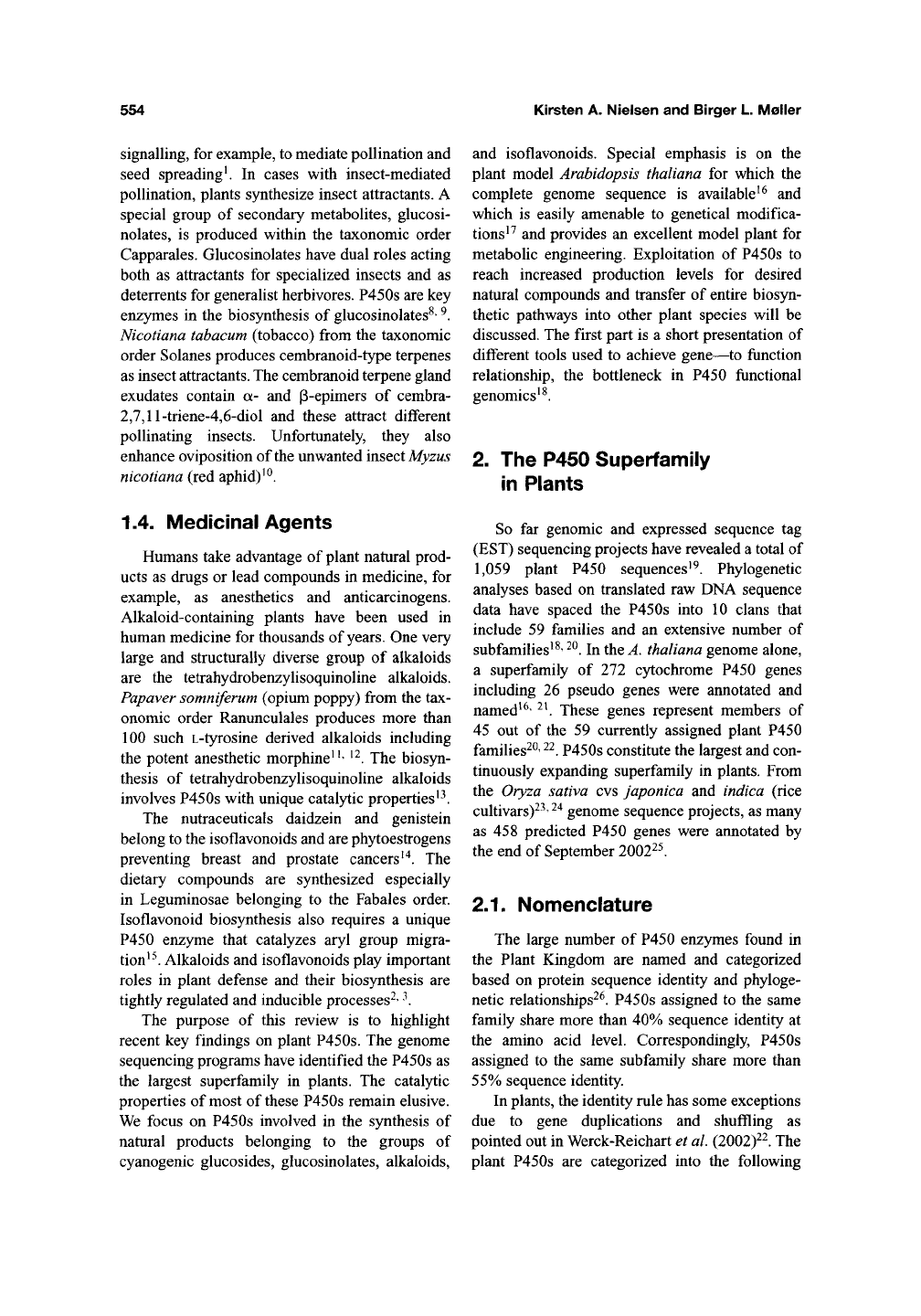
554
Kirsten A. Nielsen and Birger L. Moller
signalling, for example, to mediate pollination and
seed spreading ^ In cases with insect-mediated
pollination, plants synthesize insect attractants. A
special group of secondary metabolites, glucosi-
nolates, is produced within the taxonomic order
Capparales. Glucosinolates have dual roles acting
both as attractants for specialized insects and as
deterrents for generalist herbivores. P450s are key
enzymes in the biosynthesis of glucosinolates^' ^.
Nicotiana tabacum (tobacco) from the taxonomic
order Solanes produces cembranoid-type terpenes
as insect attractants. The cembranoid terpene gland
exudates contain a- and p-epimers of cembra-
2,7,1 l-triene-4,6-diol and these attract different
pollinating insects. Unfortunately, they also
enhance oviposition of the unwanted insect Myzus
nicotiana (red aphid)^^.
1.4. Medicinal Agents
Humans take advantage of plant natural prod-
ucts as drugs or lead compounds in medicine, for
example, as anesthetics and anticarcinogens.
Alkaloid-containing plants have been used in
human medicine for thousands of
years.
One very
large and structurally diverse group of alkaloids
are the tetrahydrobenzylisoquinoline alkaloids.
Papaver somniferum (opium poppy) from the tax-
onomic order Ranunculales produces more than
100 such L-tyrosine derived alkaloids including
the potent anesthetic morphine"' '^. The biosyn-
thesis of tetrahydrobenzylisoquinoline alkaloids
involves P450s with unique catalytic properties'^.
The nutraceuticals daidzein and genistein
belong to the isoflavonoids and are phytoestrogens
preventing breast and prostate cancers'"*. The
dietary compounds are synthesized especially
in Leguminosae belonging to the Fabales order.
Isoflavonoid biosynthesis also requires a unique
P450 enzyme that catalyzes aryl group migra-
tion^^. Alkaloids and isoflavonoids play important
roles in plant defense and their biosynthesis are
tightly regulated and inducible processes^' \
The purpose of this review is to highlight
recent key findings on plant P450s. The genome
sequencing programs have identified the P450s as
the largest superfamily in plants. The catalytic
properties of most of these P450s remain elusive.
We focus on P450s involved in the synthesis of
natural products belonging to the groups of
cyanogenic glucosides, glucosinolates, alkaloids.
and isoflavonoids. Special emphasis is on the
plant model Arabidopsis thaliana for which the
complete genome sequence is available'^ and
which is easily amenable to genetical modifica-
tions'^
and provides an excellent model plant for
metabolic engineering. Exploitation of P450s to
reach increased production levels for desired
natural compounds and transfer of entire biosyn-
thetic pathways into other plant species will be
discussed. The first part is a short presentation of
different tools used to achieve gene—^to function
relationship, the bottleneck in P450 functional
genomics
2.
The P450 Superfamily
in Plants
So far genomic and expressed sequence tag
(EST) sequencing projects have revealed a total of
1,059 plant P450 sequences'^. Phylogenetic
analyses based on translated raw DNA sequence
data have spaced the P450s into 10 clans that
include 59 families and an extensive number of
subfamilies'^'
^^.
In the A. thaliana genome alone,
a superfamily of 272 cytochrome P450 genes
including 26 pseudo genes were annotated and
named'^' ^'. These genes represent members of
45 out of the 59 currently assigned plant P450
families^^'
^^.
P450s constitute the largest and con-
tinuously expanding superfamily in plants. From
the Oryza sativa cvs japonica and indica (rice
cultivars)^^'
'^^
genome sequence projects, as many
as 458 predicted P450 genes were annotated by
the end of September 2002^^.
2.1.
Nomenclature
The large number of P450 enzymes found in
the Plant Kingdom are named and categorized
based on protein sequence identity and phyloge-
netic relationships^^. P450s assigned to the same
family share more than 40% sequence identity at
the amino acid level. Correspondingly, P450s
assigned to the same subfamily share more than
55%
sequence identity.
In plants, the identity rule has some exceptions
due to gene duplications and shuffling as
pointed out in Werck-Reichart et al (2002)^2. The
plant P450s are categorized into the following
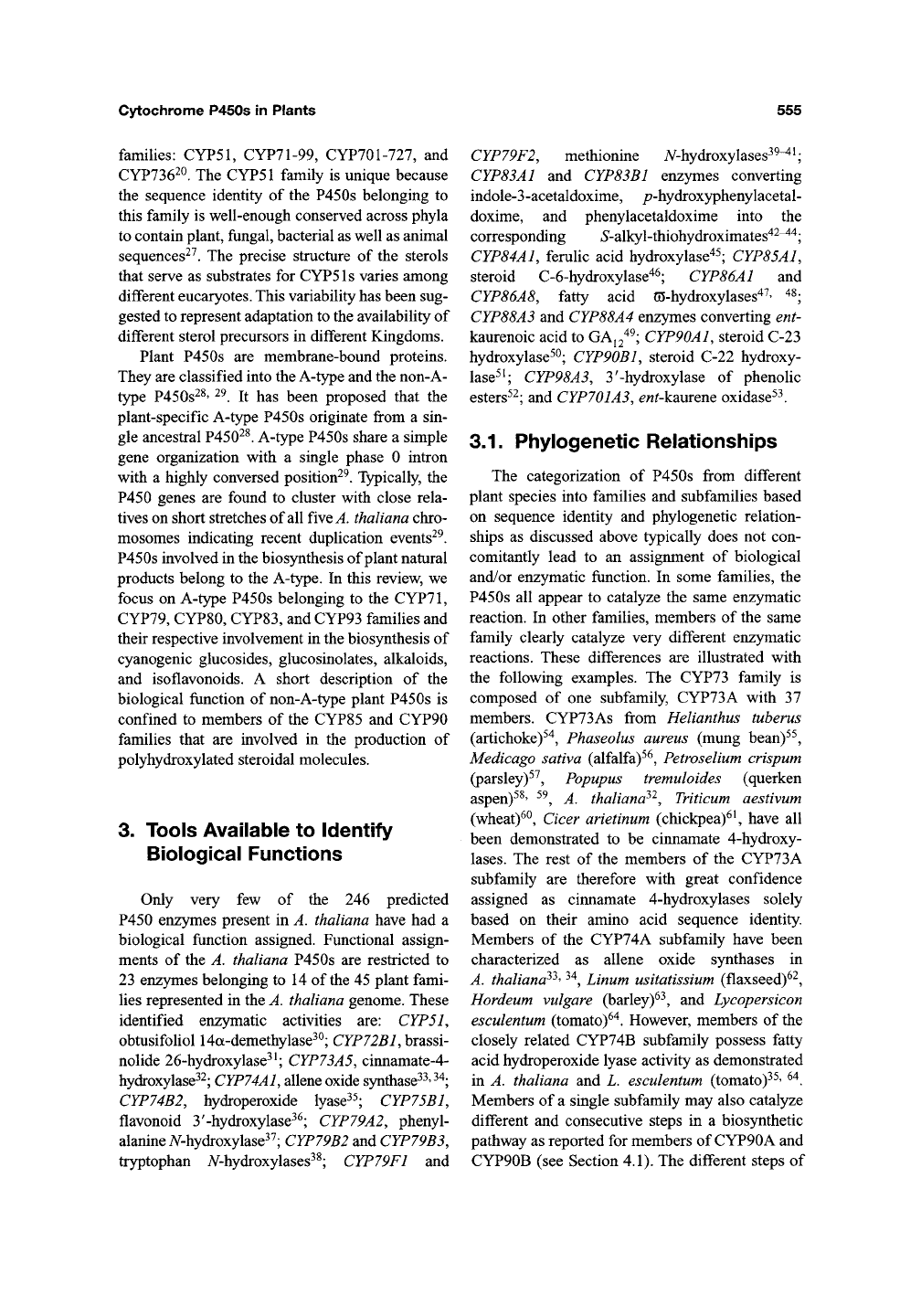
Cytochrome P450s in Plants
555
families:
CYP51,
CYP71-99, CYP701-727, and
CYP73620. The CYP51 family is unique because
the sequence identity of the P450s belonging to
this family is well-enough conserved across phyla
to contain plant, fungal, bacterial as well as animal
sequences^^. The precise structure of the sterols
that serve as substrates for CYPSls varies among
different eucaryotes. This variability has been sug-
gested to represent adaptation to the availability of
different sterol precursors in different Kingdoms.
Plant P450s are membrane-bound proteins.
They are classified into the A-type and the non-A-
type P450s^^' ^^. It has been proposed that the
plant-specific A-type P450s originate fi*om a sin-
gle ancestral P450^^. A-type P450s share a simple
gene organization with a single phase 0 intron
with a highly conversed position^^. Typically, the
P450 genes are found to cluster with close rela-
tives on short stretches of all five^. thaliana chro-
mosomes indicating recent duplication events^^.
P450s involved in the biosynthesis of plant natural
products belong to the A-type. In this review, we
focus on A-type P450s belonging to the
CYP71,
CYP79, CYP80, CYP83, and CYP93 families and
their respective involvement in the biosynthesis of
cyanogenic glucosides, glucosinolates, alkaloids,
and isoflavonoids. A short description of the
biological function of non-A-type plant P450s is
confined to members of the CYP85 and CYP90
families that are involved in the production of
polyhydroxylated steroidal molecules.
3. Tools Available to Identify
Biological Functions
Only very few of the 246 predicted
P450 enzymes present in A. thaliana have had a
biological function assigned. Functional assign-
ments of the A. thaliana P450s are restricted to
23 enzymes belonging to 14 of
the
45 plant fami-
lies represented in the A. thaliana genome. These
identified enzymatic activities are: CYP51,
obtusifoliol 14a-demethylase^^; C7P725i,brassi-
nolide 26-hydroxylase^^; CYP73A5, cinnamate-4-
hydroxylase^^;
CYP74A1,
allene oxide synthase^^'^'^;
CYP74B2, hydroperoxide lyase^^; CYP75B1,
flavonoid 3'-hydroxylase^^; CYP79A2, phenyl-
alanine iV-hydroxylase^^; CYP79B2 and CYP79B3,
tryptophan A/-hydroxylases^^; CYP79F1 and
CYP79F2, methionine TV-hydroxylases^^-^^;
CYP83A1 and CYP83B1 enzymes converting
indole-3-acetaldoxime, p-hydroxyphenylacetal-
doxime, and phenylacetaldoxime into the
corresponding ^S-alky l-thiohydroximates"^^"^"^;
CYP84A1,
ferulic acid hydroxylase^^; CYP85A1,
steroid C-6-hydroxylase^^; CYP86A1 and
CYP86A8, fatty acid G5-hydroxylases^^' 4^;
CYP88A3 and CYP88A4 enzymes converting ent-
kaurenoic acid to GA^/^; CYP90A1, steroid C-23
hydroxylase^^; CYP90B1, steroid C-22 hydroxy-
lase^^;
CYP98A3, 3'-hydroxylase of phenolic
esters^^;
and CYP701A3, ^w^kaurene oxidase^^.
3.1.
Phylogenetic Relationships
The categorization of P450s from different
plant species into families and subfamilies based
on sequence identity and phylogenetic relation-
ships as discussed above typically does not con-
comitantly lead to an assignment of biological
and/or enzymatic function. In some families, the
P450s all appear to catalyze the same enzymatic
reaction. In other families, members of the same
family clearly catalyze very different enzymatic
reactions. These differences are illustrated with
the following examples. The CYP73 family is
composed of one subfamily, CYP73A with 37
members. CYP73As from Helianthus tuberus
(artichoke)^"^, Phaseolus aureus (mung bean)^^,
Medicago sativa (alfalfa)^^, Petroselium crispum
(parsley)^^, Popupus tremuloides (querken
aspen)^^'
^^, A. thaliana^^, Triticum aestivum
(wheat)^^, Cicer arietinum (chickpea)^ ^ have all
been demonstrated to be cinnamate 4-hydroxy-
lases.
The rest of the members of the CYP73A
subfamily are therefore with great confidence
assigned as cinnamate 4-hydroxylases solely
based on their amino acid sequence identity.
Members of the CYP74A subfamily have been
characterized as allene oxide synthases in
A.
thaliana^^'
^^, Linum usitatissium (flaxseed)^^,
Hordeum vulgare (barley)^^, and Lycopersicon
esculentum (tomato)^"^. However, members of the
closely related CYP74B subfamily possess fatty
acid hydroperoxide lyase activity as demonstrated
in A. thaliana and L. esculentum (tomato)^^' ^^.
Members of a single subfamily may also catalyze
different and consecutive steps in a biosynthetic
pathway as reported for members of CYP90A and
CYP90B (see Section 4.1). The different steps of
